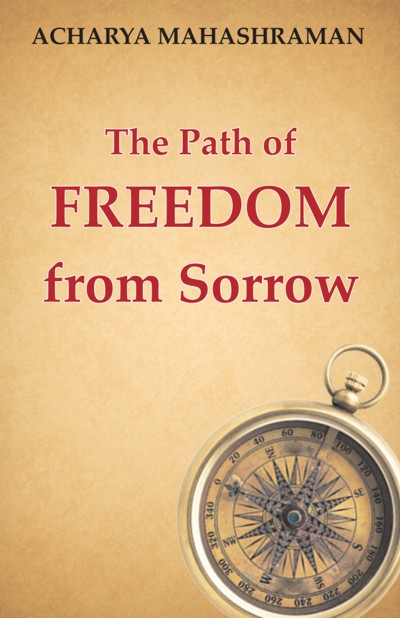King Bhartrihari, after becoming a monk, in spite of renouncing the possession, could not free himself from the attachment. Once, he saw a diamond on the road and wanted to take it immediately. Meanwhile, two horse-riders passed by. Both looked at the diamond and stepped down of the horses. One man told, 'I have seen the diamond first. So it belongs to me.' The other man said, 'no, it's mine.' The dispute began and they killed each other with the swords. Monk Bhartrihari was witnessing the entire incidence. He thought, 'this diamond is neither happy nor sad because it is not attached to anyone. It does not have any sensation. Therefore main cause of pain is attachment. Pain does not end till the attachment is.' This analysis changed the thoughts of Bhartrihari. He determined to earn the inner wealth and give up the attachment for the external affluence.
Who can attain the inner wealth? The answer is given as:
Ragdveshadikallolayralolam yanmano-jalam Sapashyatyatmanastatvam tattatvam netaro janah
The person whose mind, which is like water, does not become wavy because of the waves of attachment and aversion; who is free from these two can attain self-realization and enjoy the inner wealth. As an illustration, 'a pond is full of water. One can see the bottom if the water is clean and not wavy. A man can see his face in the mirror if it is clean, stable and unveiled. Similarly, the person whose mind is pure, clean and free from attachment and aversion can acquire the inner wealth.
A curious disciple once asked to his Guru, 'My Lord! How can I become free from attachment and aversion?' Guru replied, 'You need to practice to live in the natural state of consciousness. Here being in the natural state of consciousness means to know only and to observe only. This is a normal action. The person who simply lives with the nature lives at the level of pure consciousness. Conversely, the one who lives with fake nature is in impure consciousness. A spiritual practitioner must be aware of the purity or impurity of his nature. Pravachansar describes as
Suviditapayattha-sutto sanjamtavasamjudo vigadarago Samano samasuhadukkho bhanido suddhovaoge tti.
It means: The monk, who knows all the objects and the aphorisms perfectly, who practices restraint and penance, who is veetaraga and equanimous in pain and pleasure, is endowed with pure consciousness.
Seeing and knowing both are the necessary actions for a spiritual practitioner too. However, he is supposed to see and know only. He should maintain a state of observer. Once, a man questioned to a practitioner, 'What is your sadhana?' He said, 'I eat food when I am hungry. I drink water when I feel thirsty. I sleep when I feel like sleepy.' The man asked again, 'I also do the same. I do eat, drink and sleep. I do not see any special sadhana in what you do?' The practitioner clarifying the secret of his words said, 'I do mindful eating while eating. I consciously sleep while sleeping. I try to do my each work without attachment and aversion. While an action of a common man is inspired on and off by attachment and aversion.'
Man should practice to stay free from attachment and aversion. He should learn to observe any incident without getting attached. The person who gets attached with the incident becomes sorrowful. On the other hand the person, who just observes any instance, stays free from pain. The problems may come across the life. To come across any problem and to feel the pain caused by the problem are two different concerns. The highly spiritual people are capable, and endowed with sadhana. They know to observe a problem just being an observer. Therefore, do not become sensitive and miserable. The person who is entangled in the memory of the past, occupied in the imagination of the future does not enjoy the present. His life becomes dejected. One, who knows how to live in the present, acts with mindfulness, practices to live in thoughtless state by breaking the continuous chain of the thoughts, lives with emotional purity. Emotional purity leads a person towards conscious purity.
The practice of conscious purity means the practice of freedom from attachment and aversion. One should adopt such practices which eliminate attachment and aversion. One must have the practice to bear the favourable and unfavourable situation with equanimity. Once, a man asked to Descartes, a French philosopher, 'People disparage you. Why do you not oppose them?' Descartes responded, 'How should I oppose when I do not see anyone disparaging me.' The person said, 'How is it possible?' Descartes said, 'Whenever people disparage me I live at the level of higher consciousness where abusing words do not reach.'
Staying unaffected from favourable or unfavourable situation is in fact true spiritual practice. Emotional purity is the prime factor for spiritual uplift. When a person gets disconnected from false state of the soul and gets connected with its nature, the state of being observer is empowered. In this state no situation can make him miserable. This state of being observer opens the door for pure consciousness and opens path of freedom from sorrow
 Acharya Mahashraman
Acharya Mahashraman
